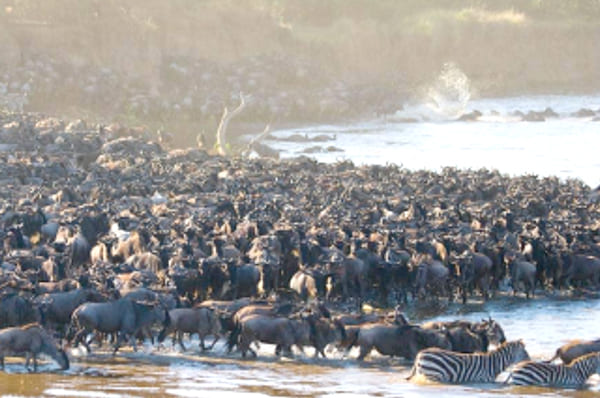Serengeti National Park


The Serengeti National Park in Tanzania, designated as a world heritage and wonder, has an incredible diversity of wildlife with over 500 species of birds and 300 species of mammals. [1] [2]
Commonly referred to as the “endless plains” by the indigenous Maasai people, the Serengeti is home to the largest remaining intact animal migration in the world, in which more than a million wildebeest and hundreds of thousands of other ungulates (gazelles, zebras) embark on an annual 1,000 km circular trek, spanning the two neighboring countries between Kenya and Tanzania. Ibid.
In addition to the great diversity of the Serengeti National Park, it has the Mara River within its boundaries.
Covering nearly 14,000 square kilometers and forming part of the Lake Victoria drainage system as well as the greater Nile basin, the Mara River basin winds through Kenya and Tanzania.[4]
The Mara River also supports a rich biodiversity, from forest ecosystems to wildebeest migration, and provides a range of services essential to both the park’s wildlife population and the human population. To name just a few of its services, the Mara River contributes to food production, economic security, and even tourism for both countries.

The integrity of the Serengeti Park and the health and sustainability of the Mara River are threatened by several interrelated factors, including the proliferation of settlements in this magnificent game reserve, human population growth, human pressure to take advantage of ecosystem services, land use change, and risks resulting from climate change. [5]
The Serengeti Park, including the Mara River, is the subject of initiatives by local actors (NGOs and activists) to recognize its rights. Given the interconnectedness of Nature – between the Serengeti Park, the Mara River, the animal population and the human population – the fragmented approach of protecting entities in isolation would not be relevant in this project. The OIDN will therefore work with Tanzanian stakeholders to develop a comprehensive approach and initiate a change in the Tanzanian legal system to give legal status to the Serengeti National Park as a whole with all its component ecosystems and species.
[1] UNESCO Centre du patrimoine mondial. (Inconnu). « Parc national de Serengeti ». Consulté le 31 juillet 2020. https://whc.unesco.org/fr/list/156/.
[2] « Informations de voyage sur le parc national du Serengeti – Tanzanie ». Consulté le 31 juillet 2020. https://www.serengeti.com/information-serengeti-national-park.html.
[3] National park Serengeti, Tanzanie. (2018). Tanzania great migration Serengeti [Photo]. Tiré de https://www.serengeti.com/index.html
[4] Sustainable Water Partnership. (Inconnu). “Why the Mara River Basin?” Consulté le 7 août 2020. https://www.swpwater.org/why-the-mara-river-basin/.
[5] L’Université norvégienne des sciences et de la technologie (NTNU). (2015, 21 mai). « Le parc du Serengeti disparaît ». ScienceDaily. Consulté le 31 juillet 2020 sur www.sciencedaily.com/releases/2015/05/150521210608.htm
[6] Sustainable Water Partnership. (Inconnu). SWP Publishes Five Studies to Support Evidence-Based Decision-Making in the Mara River Basin. [Photo]. Tiré de: Tiré de : https://www.swpwater.org/swp-publishes-five-studies-%e2%80%afto-support-evidence-based-decision-making-in-the-mara-river-basin%e2%80%af/.
